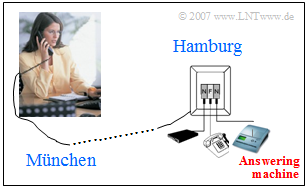Difference between revisions of "Aufgaben:Exercise 1.1Z: ISDN Connection"
From LNTwww
| (24 intermediate revisions by 4 users not shown) | |||
| Line 1: | Line 1: | ||
| − | {{quiz-Header|Buchseite= | + | {{quiz-Header|Buchseite=Signal_Representation/Principles_of_communication}} |
| − | [[File: | + | [[File:EN_Sig_Z_1_1.png|right|frame|A telephone connection scenario]] |
| − | + | We consider the scenario shown in the picture: | |
| − | + | A woman from Munich dials a number in Hamburg with her ISDN phone. However, she cannot reach the person she wants to talk to, so she leaves him a message on tape. | |
| − | + | The distortion-free connection is fully described by | |
| − | + | * an attenuation coefficient $\alpha$, | |
| − | + | * a term $\tau$ and | |
| − | + | * the current signal-to-noise ratio (SNR). | |
| − | |||
| − | |||
| − | === | + | |
| + | |||
| + | |||
| + | ''Notes:'' The task shall establish a relation between this real scenario and the functional units of a general communications system mentioned in the [[Signal_Representation/Principles_of_Communication#Block_diagram_of_a_communications_system|theory section]] . | ||
| + | |||
| + | |||
| + | |||
| + | |||
| + | ===Questions=== | ||
<quiz display=simple> | <quiz display=simple> | ||
| − | { | + | {Which of the statements are true regarding source and transmitter? |
|type="[]"} | |type="[]"} | ||
| − | + | + | + The message source is the caller. The source signal ${q(t)}$ is the acoustic wave of her speech signal. |
| − | + | + | + The unit labelled "transmitter" contains, among other things, a signal converter and a modulator. |
| − | - | + | - The transmitted signal $s(t)$ is analog. |
| − | { | + | {Which of the statements are true regarding receiver and sink? |
|type="[]"} | |type="[]"} | ||
| − | - | + | - The received signal $r(t)$ is digital. |
| − | - | + | - The message sink is the telephone set in Hamburg. |
| − | + | + | + The message sink is the answering machine. |
| − | + | + | + The following applies: $v(t) = \alpha \cdot q(t - \tau ) + {n(t)}$. |
| − | - | + | - There is an ideal transmission system. |
| Line 40: | Line 46: | ||
</quiz> | </quiz> | ||
| − | === | + | ===Solution=== |
{{ML-Kopf}} | {{ML-Kopf}} | ||
| − | '''(1)''' | + | '''(1)''' The <u>first two statements</u> are correct: |
| − | * | + | *The speech signal ${q(t)}$ must first be converted into an electrical signal and then prepared for transmission. |
| − | * | + | *For ISDN the transmitted signal ${s(t)}$ is digital. |
| + | |||
| − | '''(2)''' | + | '''(2)''' Correct are the <u>solutions 3 and 4</u>: |
| − | * | + | *The received signal ${r(t)}$ is always analog due to the unavoidable thermal noise. |
| − | * | + | *The message sink is the answering machine. |
| − | * | + | *In an ideal transmission system $v(t) = {q(t)}$ should apply. |
| − | * | + | *However, due to the additive noise term ${n(t)}$, the attenuation $\alpha$ and the delay time $\tau$ the following applies here: |
:$$v(t) = \alpha \cdot q ( t - \tau) + n(t).$$ | :$$v(t) = \alpha \cdot q ( t - \tau) + n(t).$$ | ||
| + | *By our definitions, this is a distortion-free system. | ||
{{ML-Fuß}} | {{ML-Fuß}} | ||
| − | [[Category: | + | [[Category:Signal Representation: Exercises|^1.1 Principles of Communication^]] |
Latest revision as of 16:35, 23 January 2023
We consider the scenario shown in the picture:
A woman from Munich dials a number in Hamburg with her ISDN phone. However, she cannot reach the person she wants to talk to, so she leaves him a message on tape.
The distortion-free connection is fully described by
- an attenuation coefficient $\alpha$,
- a term $\tau$ and
- the current signal-to-noise ratio (SNR).
Notes: The task shall establish a relation between this real scenario and the functional units of a general communications system mentioned in the theory section .
Questions
Solution
(1) The first two statements are correct:
- The speech signal ${q(t)}$ must first be converted into an electrical signal and then prepared for transmission.
- For ISDN the transmitted signal ${s(t)}$ is digital.
(2) Correct are the solutions 3 and 4:
- The received signal ${r(t)}$ is always analog due to the unavoidable thermal noise.
- The message sink is the answering machine.
- In an ideal transmission system $v(t) = {q(t)}$ should apply.
- However, due to the additive noise term ${n(t)}$, the attenuation $\alpha$ and the delay time $\tau$ the following applies here:
- $$v(t) = \alpha \cdot q ( t - \tau) + n(t).$$
- By our definitions, this is a distortion-free system.
